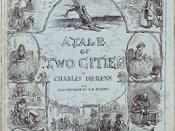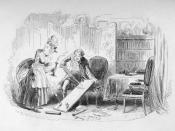A Tale of Two Cities
When writing a book, most authors are writing about an issue they have.
However, other themes become apparent through the course of the piece, either
consciously or subconsciously. One such theme is a reversal of characters in A Tale of
Two Cities. Individuals and groups of people change dramatically from the outset of the
book all the way up to its conclusion. Three of the most obvious changes in character are
Sydney Carton, Madame DeFarge, and the French people as a whole.
Sydney Carton is first described at Darnay's trial as not paying attention to what's
going on, sort of an oaf. He is portrayed as a drunk, and even admits this to Darnay on
their "date." However, love, they say, is strong; Carton's love for Lucy changed him
greatly though the course of the novel. He stopped drinking when he visited, and even
pledged his life to her, and everyone she loved.
Carton changed even more dramatically
when death on the guillotine was approaching. He waxed philosophical about the future,
and even quoted a few scriptures. This is most certainly not the man first seen at the Old
Bailey with the sideways wig.
Another interesting change took place in the character of Madame Defarge. She
is first portrayed as a woman of principle who is helping her husband with the revolution.
However, Madame Defarge makes a startling metamorphosis from supporting character
to antagonist when she is revealed to be the shadow. She is shown to be cruel and petty,
not the compassionate woman one would assume of a leader of a revolution against
tyranny. This part of the novel casts a shadow of doubt over the rest of the characters,
and one begins to question the validity of all the characters.
Finally,


